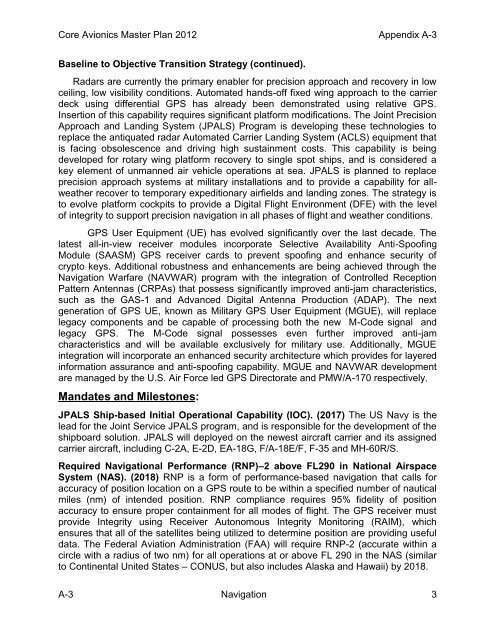PMA209 2012 Core Avionics Master Plan - NAVAIR - U.S. Navy
PMA209 2012 Core Avionics Master Plan - NAVAIR - U.S. Navy
PMA209 2012 Core Avionics Master Plan - NAVAIR - U.S. Navy
You also want an ePaper? Increase the reach of your titles
YUMPU automatically turns print PDFs into web optimized ePapers that Google loves.
<strong>Core</strong> <strong>Avionics</strong> <strong>Master</strong> <strong>Plan</strong> <strong>2012</strong> Appendix A-3Baseline to Objective Transition Strategy (continued).Radars are currently the primary enabler for precision approach and recovery in lowceiling, low visibility conditions. Automated hands-off fixed wing approach to the carrierdeck using differential GPS has already been demonstrated using relative GPS.Insertion of this capability requires significant platform modifications. The Joint PrecisionApproach and Landing System (JPALS) Program is developing these technologies toreplace the antiquated radar Automated Carrier Landing System (ACLS) equipment thatis facing obsolescence and driving high sustainment costs. This capability is beingdeveloped for rotary wing platform recovery to single spot ships, and is considered akey element of unmanned air vehicle operations at sea. JPALS is planned to replaceprecision approach systems at military installations and to provide a capability for allweatherrecover to temporary expeditionary airfields and landing zones. The strategy isto evolve platform cockpits to provide a Digital Flight Environment (DFE) with the levelof integrity to support precision navigation in all phases of flight and weather conditions.GPS User Equipment (UE) has evolved significantly over the last decade. Thelatest all-in-view receiver modules incorporate Selective Availability Anti-SpoofingModule (SAASM) GPS receiver cards to prevent spoofing and enhance security ofcrypto keys. Additional robustness and enhancements are being achieved through theNavigation Warfare (NAVWAR) program with the integration of Controlled ReceptionPattern Antennas (CRPAs) that possess significantly improved anti-jam characteristics,such as the GAS-1 and Advanced Digital Antenna Production (ADAP). The nextgeneration of GPS UE, known as Military GPS User Equipment (MGUE), will replacelegacy components and be capable of processing both the new M-Code signal andlegacy GPS. The M-Code signal possesses even further improved anti-jamcharacteristics and will be available exclusively for military use. Additionally, MGUEintegration will incorporate an enhanced security architecture which provides for layeredinformation assurance and anti-spoofing capability. MGUE and NAVWAR developmentare managed by the U.S. Air Force led GPS Directorate and PMW/A-170 respectively.Mandates and Milestones:JPALS Ship-based Initial Operational Capability (IOC). (2017) The US <strong>Navy</strong> is thelead for the Joint Service JPALS program, and is responsible for the development of theshipboard solution. JPALS will deployed on the newest aircraft carrier and its assignedcarrier aircraft, including C-2A, E-2D, EA-18G, F/A-18E/F, F-35 and MH-60R/S.Required Navigational Performance (RNP)–2 above FL290 in National AirspaceSystem (NAS). (2018) RNP is a form of performance-based navigation that calls foraccuracy of position location on a GPS route to be within a specified number of nauticalmiles (nm) of intended position. RNP compliance requires 95% fidelity of positionaccuracy to ensure proper containment for all modes of flight. The GPS receiver mustprovide Integrity using Receiver Autonomous Integrity Monitoring (RAIM), whichensures that all of the satellites being utilized to determine position are providing usefuldata. The Federal Aviation Administration (FAA) will require RNP-2 (accurate within acircle with a radius of two nm) for all operations at or above FL 290 in the NAS (similarto Continental United States – CONUS, but also includes Alaska and Hawaii) by 2018.A-3 Navigation 3

















